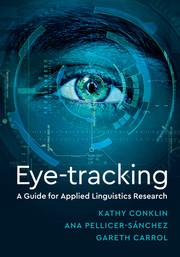Book contents
- Frontmatter
- Contents
- Figures
- Tables
- Preface
- Chapter 1 Introduction to Eye-Tracking
- Chapter 2 Choosing the Equipment
- Chapter 3 Practicalities of Eye-Tracking
- Chapter 4 Researching Reading
- Chapter 5 Researching Listening and Multimodal Input
- Chapter 6 Using Eye-Tracking in Other Contexts
- Chapter 7 Working with the Data
- Chapter 8 Conclusions
- References
- Index
6 - Using Eye-Tracking in Other Contexts
Published online by Cambridge University Press: 14 September 2019
- Frontmatter
- Contents
- Figures
- Tables
- Preface
- Chapter 1 Introduction to Eye-Tracking
- Chapter 2 Choosing the Equipment
- Chapter 3 Practicalities of Eye-Tracking
- Chapter 4 Researching Reading
- Chapter 5 Researching Listening and Multimodal Input
- Chapter 6 Using Eye-Tracking in Other Contexts
- Chapter 7 Working with the Data
- Chapter 8 Conclusions
- References
- Index
Summary
Introduction
We have remarked that eye-tracking has become widespread in psychology and psycholinguistic research over the past thirty years – it has even been referred to as the ‘gold standard’ in research in these fields (Rayner, 2009, p. 1474). As we saw in Chapters 4 and 5, much of the focus in this literature has been on establishing the influence of word characteristics (e.g. frequency, length) on processing, as well as on how comprehenders integrate words into sentences and larger contexts. Traditionally, the research has been carried out in very well-controlled studies where factors are meticulously matched. Recently, there has been an increase in the number of studies that have attempted to mimic more authentic language situations and contexts, and/or make use of authentic materials like novels, movies, television episodes, etc. We have already seen some examples of this in Chapters 4 and 5, where we looked at one study in which participants were asked to read an entire Agatha Christie novel (Section 4.3) and another in which they watched part of the SpongeBob SquarePants movie (Section 5.4). These more ‘authentic’ studies bring up a whole host of methodological considerations that were only briefly touched upon in previous chapters.
Importantly, applied linguists’ main interest is in looking at authentic language in various contexts. Eye-tracking technology is increasingly being used to study (more) authentic materials in the sub-disciplines within applied linguistics, such as language assessment, writing development, corpus linguistics, translation, computer-assisted language learning and literary linguistics. Because in many instances researchers are interested in the processing of visual input (written text, images, video, etc.) and/or auditory language input, the research has many of the same methodological considerations that we have discussed previously. However, many of their novel experimental designs raise many new methodological issues, which will be the focus of the discussion in this chapter.
As we will see as we go through the chapter, some of the sub-disciplines in applied linguistics have incorporated eye-tracking technology into their research in the last decade or so, while others have made some initial forays with the technology, and still others have not made use of it at all. By and large eye-tracking research is still in its infancy in applied linguistics.
- Type
- Chapter
- Information
- Eye-TrackingA Guide for Applied Linguistics Research, pp. 139 - 188Publisher: Cambridge University PressPrint publication year: 2018



